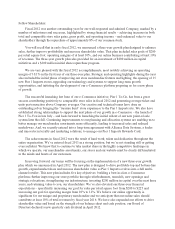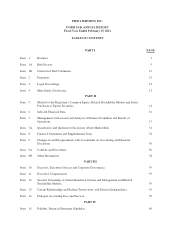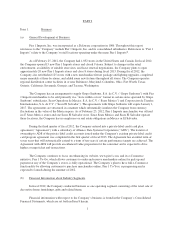Pier 1 2012 Annual Report Download - page 13
Download and view the complete annual report
Please find page 13 of the 2012 Pier 1 annual report below. You can navigate through the pages in the report by either clicking on the pages listed below, or by using the keyword search tool below to find specific information within the annual report.
leadership capacities, including Vice President – Legal Affairs, and Corporate Counsel. Mr. Carter first became
an officer of the Company in 1991 when he was named Assistant Secretary. Mr. Carter is a licensed attorney in
the State of Texas. Prior to joining the Company, Mr. Carter practiced law with the Fort Worth, Texas law firm
of Brackett and Ellis, LLP.
LAURA A. COFFEY, age 45, was named Senior Vice President of Business Development and Strategic
Planning in January 2011. Ms. Coffey has served within the organization for fifteen years in various capacities,
including most recently as Senior Vice President of Finance. Ms. Coffey first became an officer of the Company
in 2005 and was named Principal Accounting Officer in 2008. Prior to joining the Company, she held various
positions with Alcon Laboratories and KPMG, LLP.
DONALD L. KINNISON, age 54, was named Senior Vice President of Marketing and Visual
Merchandising in March 2008. Mr. Kinnison has served within the organization for twenty-two years in various
capacities, including Vice President of Visual Merchandising and Merchandise Support and Director, Visual
Merchandising. Prior to joining the Company, Mr. Kinnison held various positions with May Company and
Federated Department Stores.
The executive officers of the Company are elected by the Board of Directors and hold office until their
successors are elected or appointed and qualified or until their earlier resignation or removal. None of the above
executive officers has any family relationship with any other of such officers or with any director of the
Company. None of such officers was selected pursuant to any arrangement or understanding between her or him
and any other person, except for Mr. Smith, who pursuant to his employment agreement with the Company,
serves as President and Chief Executive Officer.
Item 1A. Risk Factors.
Strategic Risks and Strategy Execution Risks
The Company must be able to anticipate, identify and respond to changing trends and customer
preferences for home furnishings.
The success of the Company’s specialty retail business depends largely upon its ability to predict trends
in home furnishings consistently and to provide merchandise that satisfies consumer demand in a timely manner.
Consumer preferences often change and may not be reasonably predicted. A majority of the Company’s
merchandise is manufactured, purchased and imported from countries around the world and may be ordered well
in advance of the applicable selling season. Extended lead times may make it difficult to respond rapidly to
changes in consumer demand, and as a result, the Company may be unable to react quickly and source needed
merchandise. In addition, the Company’s vendors may not have the ability to handle its increased demand for
product. The seasonal nature of the business leads the Company to purchase, and requires it to carry, a significant
amount of inventory prior to its peak selling season. As a result, the Company may be vulnerable to evolving
home furnishing trends, changes in customer preferences, and pricing shifts, and may misjudge the timing and
selection of merchandise purchases. The Company’s failure to anticipate, predict and respond in a timely manner
to changing home furnishing trends could lead to lower sales and additional discounts and markdowns in an
effort to clear merchandise, which could have a negative impact on merchandise margins and, in turn, the results
of operations.
Failure by the Company to identify and successfully implement strategic initiatives could have a negative
impact on the Company.
The Company’s long-term growth, strategic plans and capital allocation strategies are dependent on the
Company’s ability to identify and successfully implement those items. If these initiatives are not properly
5
























